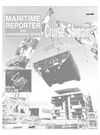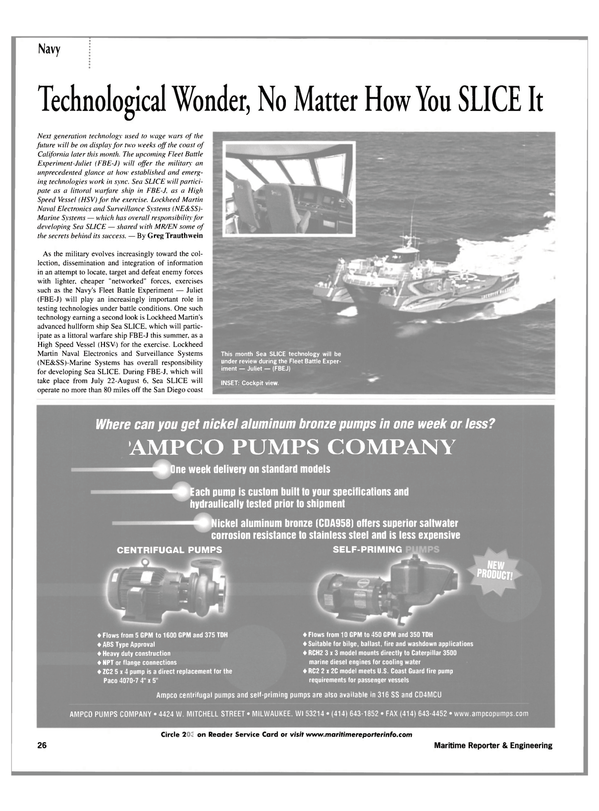
Technological Wonder, No Matter How You SLICE It
Next generation technology used to wage wars of the future will be on display for two weeks off the coast of California later this month. The upcoming Fleet Battle Experiment-Juliet (FBE-J) will offer the military an unprecedented glance at how established and emerging technologies work in sync. Sea SLICE will participate as a littoral warfare ship in FBE-J, as a High Speed Vessel (HSV) for the exercise. Lockheed Martin Naval Electronics and Surveillance Systems (NE&SS)- Marine Systems — which has overall responsibility for developing Sea SLICE — shared with MR/EN some of the secrets behind its success. — By Greg Trauthwein As the military evolves increasingly toward the collection, dissemination and integration of information in an attempt to locate, target and defeat enemy forces with lighter, cheaper "networked" forces, exercises such as the Navy's Fleet Battle Experiment — Juliet (FBE-J) will play an increasingly important role in testing technologies under battle conditions. One such technology earning a second look is Lockheed Martin's advanced hullform ship Sea SLICE, which will participate as a littoral warfare ship FBE-J this summer, as a High Speed Vessel (HSV) for the exercise. Lockheed Martin Naval Electronics and Surveillance Systems (NE&SS)-Marine Systems has overall responsibility for developing Sea SLICE. During FBE-J, which will take place from July 22-August 6, Sea SLICE will operate no more than 80 miles off the San Diego coast in a cluttered littoral combat environment against surface, sub-surface and air threats.
"Lockheed Martin is the only corporate entity represented by a ship," said George Root.
Advanced Programs Director for NE&SS-Marine Systems. Sea SLICE'S role in FBE-J is unique in that most of the crew — about two-thirds of the vessel's 20 person complement — will be Lockheed Martin personnel, with the remainder representatives from the armed forces. "We have a 35 mm gun, torpedo and missile capabilities, which is a good combat suite for a small littoral combatant," Root said. "We are a fast, stable gunboat, with the capability to escort ourselves in an armed fashion." Of particular interest is the fact that engineers will be the actual combat equipment operators, said Joe Wenderoth, Integrated Products Team Leader. This will afford the designers a frontline view of how the various systems work in the user environment of the future, providing an unequalled opportunity to integrate this experience into making a superior product.
The Pick-Up Truck Perhaps the Sea SLICE is best described as a mid-size pick-up truck with a large cargo bay, as it offers a large, flat, stable work platform from which to conduct military or commercial operations.
While Sea SLICE was invited by the Navy to exhibit its prowess as a modular base from which to conduct a variety of tasks, the vessel itself is considered a surrogate technology, meaning that the final product will like extract a number of its innovative features, but not be the entire vessel, per se. The secret of Sea SLICE'S success lies in its stability, which is significantly aided by its 2:1 length to width ratio, as well as its innovative hull design.
The ship has an advanced hullform that provides for outstanding stability and speed in high sea states and is capable of 30-plus knots in wave heights of up to 12 ft. (Sea State 5). This hullform is a variant on SWATH (Small Water-Plane Area Twin-Hull) technology and has four separate underwater hulls that provide buoyancy, propulsion, and excellent hydrodynamic efficiencies. The ship is controlled by a patented PC-based canard and stabilizer steering and motion control system.
SLICE technology is predicted to yield speeds of 45 knots in Sea State 6 (13 to 20 ft. seas); however a larger ship with greater propulsion than the existing Sea SLICE vessel is required.
Piece-by-Piece Modularity, or rather the ability to quickly change the operational hardware aboard the Sea SLICE, is one of its major selling points for military applications. The 110-ft. (33.5-m) vessel during FBE-J will enjoy the connectivity of any other Navy Ship, including an aircraft carrier, via its 1.1- m KU band antenna, among other systems. This connectivity — and the inherent ability to collect, disseminate and receive data — combined with the ability to reconfigure the vessel in a number of hours — from perhaps a minehunting vessel to a missile attack boat — is central to the Naval Warfare Development Command's work toward a network centric Navy.
"We give you a flat, wide deck capable of carrying lots of things," said Wenderoth. "We supply power and data." The ship can be reconfigured quickly by virtue that it incorporates Bolt-on, Bolt-off technology — as commonly found in the container shipping business, utilizing a hand tool to secure and loosen the bolts. This system is even used to secure weapon systems to the ship.
"(For FBE-J) we'll be working on overnight evolutions," said Wenderoth. "We'll be out all day long at sea, and change out configurations overnight, making the ship ready for morning." In exercises to highlight this modularity, the Sea SLICE will be required to perform all of the following over the two-week battle experiment.
1 Minehunting with towed sonar 2 Minehunting in shallow water with UUVs 3 Transformational Tactical Targeting technology utilized by simulated Loitering Attack Munitions (LAM) and Precision Attack Munitions (PAM) from the NetFires system, a system created by DARPA 4 High Volume fire support capability A modular Combat Information Center (CIC) in the deckhouse will provide all command and control and systems integration to effectively engage in all live fire and simulated events during FBE-J.
An integrated sensor package will include Lockheed Martin's Silent Sentry passive radar system, and three FLIR Systems Inc. sensor devices that provide infrared, electro-optical and laser ranging capabilities.
The name SLICE refers to how the ship moves through rough waters.
The concept, obviously, has drawn interest from the commercial side of the business, but perhaps of more urgent note is the interest from those entities charged with devising a coastal security system aimed at thwarting future terrorist attacks in the U.S.
Circle 189 on Reader Service Card www.maritimereporterinfo.com
Read Technological Wonder, No Matter How You SLICE It in Pdf, Flash or Html5 edition of July 2002 Maritime Reporter
Other stories from July 2002 issue
Content
- Zodiac Debuts Bulletproof System For CRRC page: 5
- Historic $17 Billion Order Placed page: 6
- USCG Proposes New Changes in Vessel Arrival/Departure Procedures page: 9
- NASSCO Celebrates Keel Laying of Trailerships page: 11
- Industry-Wide Interoperability Investment Paying Off page: 12
- Tribon M2 Aim: Better Ships at a Lower Cost page: 14
- Total CAD/CAM Solution for Ship Design and Building page: 15
- Juniper Industries Keeps the Water Out page: 17
- Molding the five-deck Trailership page: 18
- IZAR Gijon Delivers Dredger page: 19
- Estonians Raise the Ferry Stakes page: 19
- Transportation Secretary Announces $92.3M in Port Security Grants page: 21
- USS Shoup Commissioned page: 23
- U.K. Royal Navy Increases Overhaul Efficiency of HP Air Cylinders page: 24
- DD(X) Dispute: BIW Files Protest page: 25
- Technological Wonder, No Matter How You SLICE It page: 26
- GALILEO: 2008 or Bust? page: 28
- Forget the Dog, MTN Delivers the News Onboard Residensea page: 29
- SeaWave Aims to Drive Down Communication Costs page: 29
- Iridium Aggressively Pursues New Outlets page: 30
- Fincantieri Stays Strong page: 32
- Fincantieri Predicts Clear Vista For HAL page: 32
- Rodriquez Cantieri Navali: Fast Company page: 33
- SEA RIDER Infiltrates Small Craft Propulsion Market page: 34
- ACG Makes Solid Inroads page: 35
- SubSea Solutions Alliance Provides Quick Fix - Underwater page: 36
- Classic Vessel's Demise Lead to New Found Hobby page: 38
- STAR Center Provides 360-Degree Field of View page: 41
- MAN B&W 48/60B Engine page: 42
- Titan Pulls One Off for Marine Response Alliance page: 54


